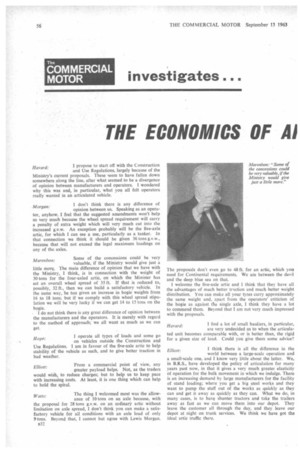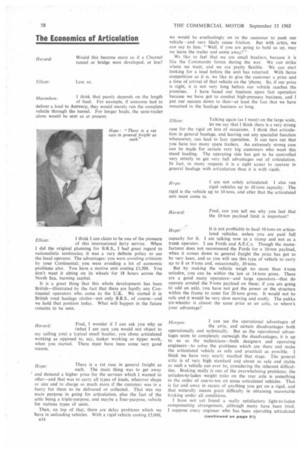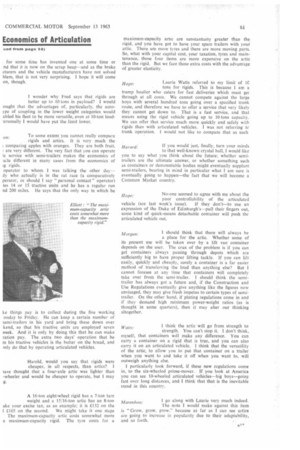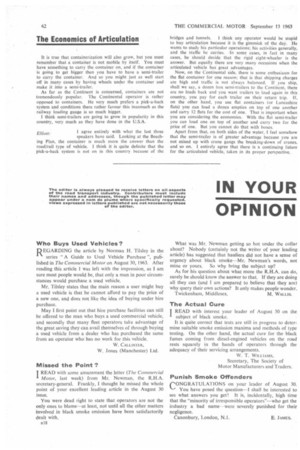THE ECONOMICS OF Ai
Page 58

Page 59

Page 60

Page 63

Page 64

If you've noticed an error in this article please click here to report it so we can fix it.
IRON an operator l feel that
ments won't help us the suggested amend very much . ."
Havard: I propose to start off with the Construction and Use Regulations, largely because of the Ministry's current proposals. These seem to have fallen down somewhere along the line, after what seemed to be a divergence of opinion between manufacturers and operators. I wondered why this was and, in particular, what you all felt operators really wanted in an articulated vehicle.
I don't think there is any difference of opinion between us. Speaking as an operator, anyhow. I feel that the suggested amendments won't help us very much because the wheel spread requirement will carry a penalty of extra weight which will very much cut into the increased g.v.w. An exception probably will be the five-axle artic, for which I can see A use, particularly as a tanker. In that connection we think it should be given 36 tons g.v.w., because that will not exceed the legal maximum loadings on any of the axles.
Morgan: Some of the concessions could be very valuable, if the Ministry would give just a little more. The main difference of opinion that we have with the Ministry, I think, is in connection with the weight of 30 tons for the four-axled artic, on which the Minister has set an overall wheel spread of 35 ft. If that is reduced to, possibly, 32 ft., then we can build a satisfactory vehicle. In the same way, he has given an increase in bogie weights from 16 to 18 tons; but if we comply with this wheel spread stipulation we will be very lucky if we can get 14 to 15 tons on the bogie.
I do not think there is any great difference of opinion between the manufacturers and the operators. It is merely with regard to the method of approach; we all want as much as we can get. Marenbon: I operate all types of loads and some go on vehicles outside the Construction an.d Use Regulations. I am in favour of the five-axle artic to help stability of the vehicle as such, and to give better traction in bad weather. Hope: From a commercial point of view, any greater payload helps. Not, as the traders would wish, to reduce charges; but to help us to keep pace with increasing costs. At least, it is one thing which can help to hold the spiral. Elliott: The thing 1 welcomed most was the allowance of 10 tons on an axle because, with the proposal for 28 tons g.v.w. on an ordinary artic without limitation on axle spread, I don't think you can make a satisfactory vehicle for all conditions with an axle load of only 9 tons. Beyond that, I cannot but agree with Lewis Morgan. Watts: The proposals don't even go to 48 ft. for an artic, which you need for Continental requirements. We are between the devil and the deep blue sea on that.
I welcome the five-axle artic and I think that they have all the advantages of much better traction and much better weight distribution. You can make all your tyres carry approximately the same weight and, apart from the operators' criticism of the bogie as against the single axle, I think they have a lot to commend them. Beyond that I am not very much impressed with the proposals.
I find a lot of small hauliers, in particular, are very undecided as to when the articulated unit becomes comparable with, or is better than, the rigid for a given size of load. Could you give them some advice? Havard: I think there is all the difference in the world between a large-scale operation and a small-scale one, and I know very little about the latter. We, in B.R.S., have developed the policy of articulation for many years past now, in that it gives a very much greater elasticity of operation for the bulk movement in which we indulge. There is an increasing demand by large manufacturers for the facility of stand loading; where you get a big steel works and they want to pump the stuff out of the works as quickly as they can and get it away as quickly as they can. What we do, in many cases, is to have shunter tractors and take the trailers away as fast as we can move them into our depot. They leave the customer all through the day, and they leave our depot at night on trunk services. We think we have got the ideal artic traffic there. Elliott: is another factor, and that is the fact of being able ■ the same driver on the same motive unit. It is bad in le to have too many drivers on the same vehicle, which ist have in the change-over of rigids. Also, with arties, : the chap back home. The men of today are claiming )isure time; they don't want too much disturbance, and do get it they want more money. The saving in subis also a very important factor.
with all the numerous advantages of articulation, I have feeling that we could have gone far enough in articula
think there is an excessive tendency for operators to r more and more articulation when they haven't rily evaluated the advantages of rigid compared with tion. This is not decrying articulation, but there are
for courses. The articulated vehicle is heavier in weight, it costs more in taxation, and it has slightly )ayload than the rigid. But there are many advantages ....onsiderably outweigh those disadvantages.
think, though, that any operator, in contemplating the ernatives, wants to have full regard to all the pros and :fore diving into one end or the other, particularly in into articulation I enjoy the sweets of articulation; but I don't like taking the castor oil from bad ring and, perhaps, bad driving.
Still on the question of operation, may I just make one point which I omitted; it advantage to a large-scale operator such as ourselves, in that you get quite a number of demands for special types of traffic which require a special semi-trailer. A semi-trailer is comparatively cheap, capitalwise. If that semi-trailer stands idle three days a week, it isn't of the highest importance as long as you (as I said earlier on) are maintaining your motive unit in full operation 24 hours a day, seven days a week.
It can be of great advantage to have the odd box trailer, bulk-loading trailer, bulk powder or even bulk liquid or lowloader unit, which can stand in the yard. You can give it quite a long life and you can pull it out when occasion demands.
Marenbon: I think Harold has covered the subject very
adequately, especially the last part concerning the flexibility of the semi-trailer. The fact that you can have several alternative semi-trailers with a single motive unit is of very great advantage especially to the smaller operator, and that is but one side of the matter.
As far as economics of operation are concerned, you must bear in mind that if you want to carry 13or 14-ton loads, then the articulated outfit would probably give you the cheapest way of doing it as far as capital cost is concerned and, would imagine, as far as running cost is concerned too.
Watts: I would reinforce what Harold said, because
semi-trailers in my experience (and, I hope, in his) seem to last 20 years and more, whereas the prime mover may last very much less. The big advantage is that you can vary your choice of prime mover according to the times. For example, if, in the next few years, somebody comes out with a really first-class two-pedal control ata reasonable figure, you would be able to keep up with the times while still maintaining your special-purpose back-end which will last a very long time.
The other point I would like to make, reinforcing what Arthur Marenbon said, is that you can get a very much better and more stable loading line on a drop-frame semi-trailer. You may have specialized machinery carriers, bulk solid carriers, tankers, or any special-purpose carrier, all on your one bas:c • prime mover. That, in itself, to my mind allows the operator to standardize on one or two makes of tractor and have all the flexibility that he can possibly desire on the load that he carries.
Marenbon: Could I add a footnote to what I said, and
that is that I did omit to speak about the advantages of semi-trailers from the point of view of international transport. It is one of the advantages of the articulated vehicle, inasmuch as you can send the semi-trailers abroad so very easily. It isn't necessary to send the prime mover. I think that purely depends on the length of haul. For example, if someone had to deliver a load to Antwerp, they would merely run the complete vehicle through the tunnel For longer hauls, the semi-trailer alone would be sent as at present. Marenbon: I think I can claim to be one of the pioneers of this international ferry service. When 1 did the original planning for B.R.S., I had great regard to nationalistic tendencies; it was a very definite policy to use the local operator. The advantages: you were avoiding criticism by your Continental; you were avoiding a lot of economic problems also. You have a motive unit costing £3,500. You don't want it sitting on its wheels for 18 hours across the North Sea, burning capital.
It is a great thing that this whole development has been British—illustrated by the fact that there are hqdly any Continental operators who come to the U.K. We started it in British road haulage circles—not only B.R.S., of course—and we hold that position today. What will happen in the future remains to be seen. Elliott: Havard: Fred, I wonder if I can ask you why as (what I am sure you would not object to my calling you) a typical small haulier, you chose articulated working as opposed to, say, tanker working or tipper work, when you started. There must have been some very good reason.
There is a rat race in general freight as such. The main thing was to get away and demand a higher price for the services which I wanted to offer—and that was to carry all types of loads, whatever shape or size and to charge so much more if the customer was in a hurry for them to be delivered or collected. That was my main purpose in going for articulation, plus the fact of the artic being a triple-purpose, and maybe a four-purpose, vehicle for various types of units.
Then, on top of that, there are delay problems which we have in unloading vehicles. With a rigid vehicle costing £5,000, e34 Hope: we would be everlastingly on to the customer to push our vehicle—and very likely cause friction. But with artics, we can say to him: "Well, if you are going to hold us up, may we leave the trailer and come away?"
We like to feel that we are small hauliers, because it is like the Commando forces during the war. We can strike where we want, and we are pretty flexible. We can start looking for a load before the unit has returned. With fierce competition as it is, we like to give the customer a price and a time of arrival of that vehicle on the 'phone. So, if our price is right, it is not very long before our vehicle reaches the
premises. I have based our business upon fast operation because we have got to combat high-pressure business, and I put our success down to that—at least the fact that we have remained in the haulage business so long.
Elliott: Talking again (as I must) on the large scale,
let me say that I think there is a very strong case for the rigid on lots of occasions. I think that articulation in general haulage, and leaving out any specialist function whatsoever, can lead to lazy operation. It can turn out that you have too many spare trailers. An extremely strong case can be made for certain very big customers who want this stand loading. The operating side has got to be controlled very strictly to get very full advantages out of articulation. In fact, in many respects it is a sight easier to operate in general haulage with articulation than it is with rigids.
I am not solely articulated. I also run rigid vehicles up to 10 tons capacity. The rigid is the vehicle up to 10 tons, and after that the articulated unit must come in.
Hope: Fred, can you tell me why you feel that the 10-ton payload limit is important?
•
Hope: It is not profitable to haul 10 tons on articu lated vehicles, unless you are paid full capacity for it. I am talking now as a tramp and not as a trunk operator. I use Fords and A.E.C.s. Though the manufacturer does not recommend the Fords for a 10-ton payload, when it comes down to general freight the price has got to be very keen, and so you will use this type of vehicle to carry up to 8 or 9 tons and, occasionally, 10 tons.
But by making the vehicle weigh no more than 4 tons unladen, you can be within the law at 14 tons gross. There are a good many operators—and large operators—that do operate around the 9 tons payload on these; if you are going to add an axle, you have not got the power or the structure within the frame to cater for 20 tons gross. It would not be safe and it would be very slow moving and costly. The pukka six-wheeler is almost the same price as an artic, so where's your advantage?
Mor I can see the operational advantages of gan:
the artic, and certain disadvantages both operationally and technically. But as the operational advantages seem to completely outweigh the disadvantages, it is up to us as the technicians—both designers and operating engineers—to solve the problems which are there and make the articulated vehicle as safe and practical as possible. I think we have very nearly reached that stage. The general artic is of very high standard and about as safe and stable as such a vehicle can ever be, considering the inherent difficulties. Braking really is one of the overwhelming problems; the unladen-to-laden weight ratio on the rear axle is something in the order of one-to-ten on some articulated vehicles. That is far and away in excess of anything you get on a rigid, and that naturally means great difficulty in obtaining reasonable braking under all conditions.
I have not yet found a really satisfactory light-to-laden compensating arrangement, although many have been tried. I suppose every engineer who has been operating articulated (continued on page et) for some time has invented one at some time or .nd that it is now on the scrap heap—and as the brake cturers and the vehicle manufacturers have not solved blem, that is not very surprising. I hope it will come on, though.
I wonder why Fred says that rigids are better up to 10 tons in payload? I would ought that the advantages of, particularly, the autoype of coupling in the lower weight categories would abled his fleet to be more versatile, even at 10-ton load'ersonally I would have put the limit lower.
To some extent you cannot really compare rigids and artics. It is very much the
comparing apples with oranges. They are both fruit, r are very different. The very fact that you can operate Ee service with semi-trailers makes the economics of u;te different in many cases from the economics of ig rigids.
operator to whom I was talking the other daydy who actually is in the rat race (a comparatively perator, or should I say "personal contact" operator) tes 14 or 15 tractive units and he has a regular run nd 200 miles. He says that the only way in which he
ke things pay is to collect during the five working onday to Friday. He can keep a certain number of semi-trailers in his yard and bring these down over kend, so that his tractive units are employed seven week. And it is only by doing this that he can make ration pay. The extra two days' operation that he m his tractive vehicles is the butter on the bread, and mly do that by operating articulated vehicles.
Harold, would you say that rigids were cheaper, in all respects, than artics? lave thought that a four-axle artic was lighter than -wheeler and would be cheaper to operate, but I may g.
A 16-ton eight-wheel rigid has a 7-ton tare weight and a 15116-ton artic has an 8-ton ake your excise tax, as an example: it is £132 on the I £165 on the second. We might take it one stage The maximum-capacity artic costs somewhat more e maximum-capacity rigid. The tyre costs for a maximum-capacity mite are substantially greater than the rigid, and you have got to have your spare trailers with your artic. There are more tyres and there are more moving parts. So, what with your capital cost, your taxation, tyres and maintenance, those four items are more expensive on the artic than the rigid. But we face those extra costs with the advantage of greater elasticity.
Ho Laurie Watts referred to my limit of 10
pe:
tons for rigids. This is because I am a tramp haulier who caters for fast deliveries which must get through at all costs. We cannot compete against the large boys with several hundred tons going over a specified trunk route, and therefore we have to offer a service that very likely they cannot get down to. That is a fast service, and that means using the rigid vehicle going up to 10 tons capacity. We can offer that service much more quickly and safely with rigids than with articulated vehicles. I was not referring to trunk operation. I would not like to compare that as such If you would just, finally, turn your minds to that well-known crystal ball, I would like you to say what you think about the future; whether semitrailers are the ultimate answer, or whether something such as containers or demountable bodies might eventually supplant semi-trailers, bearing in mind in particular what I am sure is eventually going to happen—the fact that we will become a Common Market country.
Havard:
No-one seemed to agree with me about the poor controllability of the articulated vehicle (see last week's issue). If they don't—to use an expression of the Duke of Edinburgh's—pull their fingers out, some kind of quick-means detachable container will push the articulated vehicle out.
Memgan: I should think that there will always be a place for the artic. Whether some of its present use will be taken over by a lift van container depends on the user. The crux of the problem is if you can get containers always passing through depots which are sufficiently big to have proper lifting tackle, if you can lift easily, quickly and cheaply, surely a container is a far easier method of transferring the load than anything else? But I cannot foresee at any time that containers will completely• take over from the semi-trailer. I should think the semitrailer has always got a future and, if the Construction and Use Regulations eventually give anything like the figures now envisaged, they may give fresh impetus to certain types of semitrailer. On the other hand, if plating regulations come in and if they demand high minimum power-weight ratios (as is thought in some quarters), then it may alter our thinking altogether.
Waits: I think the artic will go from strength to
strength. You can't stop it. I don't think, myself, that containers will make any difference. You can carry a container on a rigid that is true, and you can also carry it on an articulated vehicle. I think that the versatility of the artic, to allow you to put that container on a trailer when you want to and take it off when you want to, will outweigh anything else.
I particularly look forward, if these new regulations come in, to the six-wheeled prime-mover. If you look at America you can see 10-wheeled articulated vehicles—big boys—going fast over long distances, and I think that that is the inevitable trend in this country.
I go along with Laurie very much indeed. The note I would make against this item is "Grow, grow, grow." because as far as I can see artics are going to increase in popularity due to their adaptability, and so forth.
Marenbon:
It is true that containerization will also grow, but you must remember that a container is not mobile by itself. You must have something to carry the container on, and if the container is going to get bigger then you have to have a semi-trailer to carry the container. And so you might just as well start off in many cases by having wheels under the container and make it into a semi-trailer.
As far as the Continent is concerned, containers are not tremendously popular. The Continental operator is rather opposed to containers. He very much prefers a pick-a-back system and conditions there rather favour this inasmuch as the railway loading gauge is so much bigger.
I think semi-trailers are going to grow in popularity in this country, very much as they have done in the U.S.A.
Elliott: I agree entirely with what the last three speakers have said. Looking at the Beeching Plan, the container is much more the answer than the road/rail type of vehicle. I think it is ,quite definite that the pick-a-back system is not on in this country because of the
bridges and tunnels. I think any operator would be stupid to buy articulation because it is the gimmick of the day. He wants to study his particular operations; his activities generally, and the traffic he carries. In some cases, in fact in many cases, he should decide that the rigid eight-wheeler is the answer. But equally there are very many occasions when the articulated vehicle has great advantages.
Now, on the Continental side, there is some enthusiasm for the flat container for one reason; that is that shipping charges are high and traffic is not always balanced, If you ship, shall we say, a dozen box semi-trailers to the Continent, there are no loads back and you want trailers to load again in this country, you pay for each trailer on their return trip. If, on the other hand, you use flat containers (or Lancashire flats) you can load a dozen empties on top of one another and carry 12 flats for the cost of one. That is important when you are considering the economics. With the fiat semi-trailer you can load one on top of another and carry two for the price of one. But you cannot do that with boxes.
Apart from that, on both sides of the water, 1 feel somehow that the semi-trailer is of greater advantage because you are not mixed up with crane gangs the breaking-down of cranes, and so on. I entirely agree that there is a continuing future for the articulated vehicle; taken in its proper perspective.




















































































































